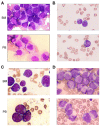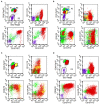Clinical profile in KMT2A-SEPT6- positive acute myeloid leukemia: Does it often co-occur with NRAS mutations?
- PMID: 36213638
- PMCID: PMC9532577
- DOI: 10.3389/fmed.2022.890959
Clinical profile in KMT2A-SEPT6- positive acute myeloid leukemia: Does it often co-occur with NRAS mutations?
Abstract
Background: The KMT2A-SEPT6 fusion gene is a relatively rare genetic event in leukemia. Its clinical characteristics and prognosis, especially the profile of co-occurring gene mutations remain unclear.
Methods: We retrospectively analyzed the characteristics of four cases carrying KMT2A-SEPT6 in our hospital, and provided a literature review.
Results: All the four patients were diagnosed with acute myeloid leukemia (AML) and harbored X chromosome and 11 chromosome rearrangements, they all manifested high levels of D-dimer. Three of four patients had NRAS mutations while one patient with congenital AML did not. Of the four cases, one developed drug resistance, one suffered relapse after bone marrow transplantation (BMT) and two died. Combined with other cases reported in the literature, we found that of all patients diagnosed with AML, 90.9% were children (≤9 years old). Patients with white blood cells ≥20.0 × 109/L or diagnosed with M4 had a shorter overall survival (P < 0.05). Age, whether to receive BMT, and the chromosome rearrangement patterns had no significant effect on overall survival (P > 0.05).
Conclusions: KMT2A-SEPT6 was more commonly observed in pediatric AML patients, some of which may co-occur with NRAS mutations. The prognosis was related to the white blood cell levels and the leukemia subtype, but was not related to age or BMT. More cases need to be accumulated to better understand the profile in KMT2A-SEPT6-positive AML.
Keywords: KMT2A-SEPT6; NRAS; acute myeloid leukemia; gene rearrangement; mutations.
Copyright © 2022 Chen, Yang and Fu.
Conflict of interest statement
The authors declare that the research was conducted in the absence of any commercial or financial relationships that could be construed as a potential conflict of interest.
Figures




Similar articles
-
Co-existence of KMT2A::SEPTIN6 fusion and DIS3 variant in a pediatric case with acute myeloid leukemia: a case report and literature review.Front Oncol. 2023 Dec 13;13:1308786. doi: 10.3389/fonc.2023.1308786. eCollection 2023. Front Oncol. 2023. PMID: 38152368 Free PMC article.
-
Mutational landscape and clinical outcome of pediatric acute myeloid leukemia with 11q23/KMT2A rearrangements.Cancer Med. 2023 Jan;12(2):1418-1430. doi: 10.1002/cam4.5026. Epub 2022 Jul 14. Cancer Med. 2023. PMID: 35833755 Free PMC article.
-
Mutational landscape and clinical outcome of patients with de novo acute myeloid leukemia and rearrangements involving 11q23/KMT2A.Proc Natl Acad Sci U S A. 2020 Oct 20;117(42):26340-26346. doi: 10.1073/pnas.2014732117. Epub 2020 Oct 5. Proc Natl Acad Sci U S A. 2020. PMID: 33020282 Free PMC article.
-
Rare KMT2A-ELL and Novel ZNF56-KMT2A Fusion Genes in Pediatric T-cell Acute Lymphoblastic Leukemia.Cancer Genomics Proteomics. 2021 Mar-Apr;18(2):121-131. doi: 10.21873/cgp.20247. Cancer Genomics Proteomics. 2021. PMID: 33608309 Free PMC article. Review.
-
KMT2A-ARHGEF12, a therapy related fusion with poor prognosis.Mol Biol Rep. 2021 Oct;48(10):7021-7027. doi: 10.1007/s11033-021-06621-5. Epub 2021 Aug 12. Mol Biol Rep. 2021. PMID: 34383244 Review.
Cited by
-
Co-existence of KMT2A::SEPTIN6 fusion and DIS3 variant in a pediatric case with acute myeloid leukemia: a case report and literature review.Front Oncol. 2023 Dec 13;13:1308786. doi: 10.3389/fonc.2023.1308786. eCollection 2023. Front Oncol. 2023. PMID: 38152368 Free PMC article.
References
-
- Wander P, Arentsen-Peters STCJM, Pinhan?os SS, Koopmans B, Dolman MEM, Ariese R, et al. . High-throughput drug screening reveals Pyrvinium pamoate as effective candidate against pediatric MLL-rearranged acute myeloid leukemia. Transl Oncol. (2021) 14:101048. 10.1016/j.tranon.2021.101048 - DOI - PMC - PubMed
LinkOut - more resources
Full Text Sources
Miscellaneous

